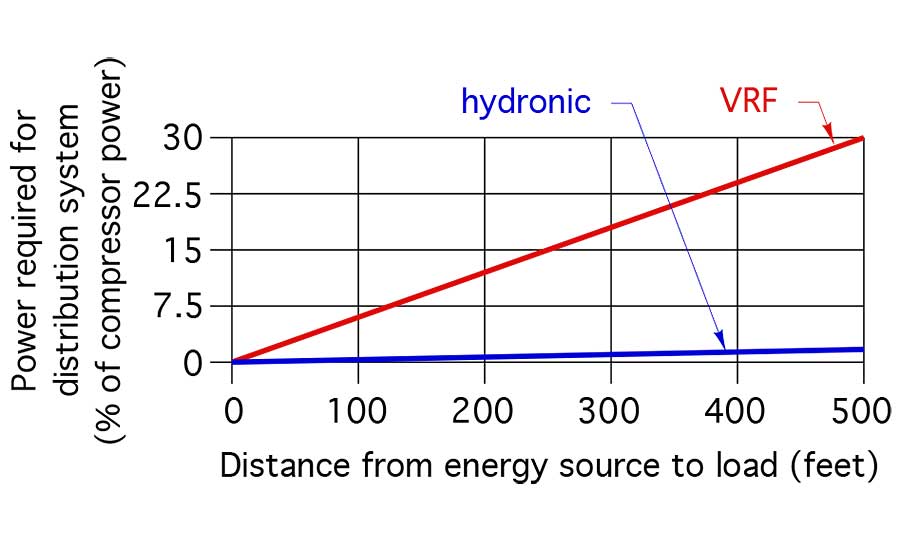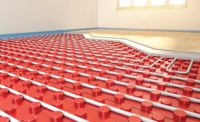During the four decades that I’ve been involved in the North American hydronics industry, there have been significant improvements in the thermal efficiency of hydronic heat sources.
The 1960s vintage ranch house I grew up in is a good example. When built, it was fitted with a baseboard-heating system supplied by an oil-fired steel fire-tube boiler. The boiler was equipped with a tankless coil for domestic water heating. A Honeywell “round” thermostat controlled the entire 1,500-square-foot house as a single zone.
When I eventually replaced that boiler, the baffles inside the fire tubes were completely burned away. This helped explain the net stack temperature of about 550° F. Although this boiler kept the house comfortable for more than 30 years, its “aged” seasonal efficiency was probably in the range of 50 to 60%.
Today, the house has another oil-fired boiler with a rated heating capacity about half that of its predecessor and a rated AFUE of 86%. But even that performance number looks mediocre compared to currently available modulating/condensing boilers that can operate with thermal efficiencies in the mid-90% range when paired up with a low temperature load.
As good as it gets?
Upon hearing some modern boilers can operate with thermal efficiencies upwards of 95%, many potential clients likely conclude the industry has just about reached the limit of what’s possible with regard to converting fuel into heat, and that little remains to be accomplished in terms of improving the efficiency of systems using such boilers. But, just as an oasis fades away when you’re almost to it, so does this illusion of nearly perfect efficiency.
True, the thermal efficiency of modern boilers, when properly applied, can be very high, but a hydronic system is more than a high-performance boiler. For the system to be considered high performance it should have a highly-efficient heat source as well as be able to move heat through a building using minimal amounts of electrical energy. The latter criteria can be quantified using an index called distribution efficiency, which can be defined as follows:
 Distribution efficiency has nothing to do with converting any type of fuel into heat. Instead, it describes how many Btu/h of heat the distribution system can move from the heat source to the heat emitters for each watt of electrical power supplied to operate that distribution system. The more heat the distribution system can deliver per watt of electrical power demand the higher its distribution efficiency.
Distribution efficiency has nothing to do with converting any type of fuel into heat. Instead, it describes how many Btu/h of heat the distribution system can move from the heat source to the heat emitters for each watt of electrical power supplied to operate that distribution system. The more heat the distribution system can deliver per watt of electrical power demand the higher its distribution efficiency.
Here’s an example: Consider a hydronic system that delivers 120,000 Btu/h at design-load conditions using four circulators operating at 85 watts each. The distribution efficiency of that system is:
 But is 353 Btu/h/watt an acceptably high value for distribution efficiency? It’s hard to judge a number for any physical measurement without something to compare it to.
But is 353 Btu/h/watt an acceptably high value for distribution efficiency? It’s hard to judge a number for any physical measurement without something to compare it to.
Here is a similar calculation for a furnace with a blower that operates at 850 watts while delivering 80,000 Btu/h through a forced-air ducting system:
 For these two examples, the hydronic system provides a distribution efficiency about 3.8 times higher than that of the forced-air system. That distinct advantage is the direct result of water being far superior to air as a material for absorbing heat.
For these two examples, the hydronic system provides a distribution efficiency about 3.8 times higher than that of the forced-air system. That distinct advantage is the direct result of water being far superior to air as a material for absorbing heat.
Using modern hardware and careful design, it’s possible to create hydronic distribution systems with distribution efficiencies well beyond the 353 Btu/h/watt value of the previous example.
Imagine a building with a design heat loss of 62,500 Btu/h, being supplied with a circulator input power requirement of 25 watts. That situation represents a distribution efficiency of 2,500, and it’s very doable with today’s off-the-shelf hardware, combined with well-thought-out piping practices.
The untold story
I’m reasonably sure some of the hydronic heating pros reading this article have never heard of distribution efficiency or used it to promote the inherent advantages of hydronic systems. Perhaps those professionals go from one system proposal to the next telling potential clients about boilers that may have thermal efficiencies of 95%, or showing photos of their “trophy” installation where 20 identical circulators are neatly lined up along the mechanical room wall. Based on that approach they win some proposals, lose others and occasionally wonder why the hydronics industry in North America is not growing nearly as fast as other HVAC market segments.
At a time when many potential clients respond to marketing based on assurances of “high efficiency,” the North American hydronics industry, as a whole, seems lethargic at exploiting the inherently superior energy efficiency of water-based heating and cooling distribution systems.
Consider, for example, mini-split ductless heat pumps and their larger commercial cousins, VRF (variable-refrigerant flow) systems. These methods of moving thermal energy though buildings using refrigerant piping are two of the fastest-growing market segments in the HVAC industry. This despite the fact that their distribution efficiencies are much lower than hydronic distribution systems, according to Greg Cunniff’s pme article from July 2013 entitled “Hydronics offers a cool, comfortable advantage.” See Figure 1 here.
 Another example is water-to-air geothermal heat pumps. Over the last several years geothermal heat pumps have become another darling of the North American HVAC industry. This market segment rests its case on higher coefficients of performance ratings relative to those of much less-expensive air-source heat pumps. But what about the distribution efficiency of a water-to-air geothermal heat-pump system?
Another example is water-to-air geothermal heat pumps. Over the last several years geothermal heat pumps have become another darling of the North American HVAC industry. This market segment rests its case on higher coefficients of performance ratings relative to those of much less-expensive air-source heat pumps. But what about the distribution efficiency of a water-to-air geothermal heat-pump system?
Using published operating data from one manufacturer, and including the effect of power factor, I estimated the power input to the standard (non-ECM) blower motor of a nominal 4-ton water-to-air heat pump at 1,050 watts. Assuming the heat pump operates at conditions where its output is 48,000 Btu/h, its corresponding distribution efficiency is:
 That’s much lower than the potential distribution efficiency of a well-designed hydronic system, and yet this stark difference goes largely ignored by heating professionals, utilities, energy auditors, government agencies and even politicians prodded by lobbyists, all of whom tend to focus on high thermal efficiency (e.g., high COP).
That’s much lower than the potential distribution efficiency of a well-designed hydronic system, and yet this stark difference goes largely ignored by heating professionals, utilities, energy auditors, government agencies and even politicians prodded by lobbyists, all of whom tend to focus on high thermal efficiency (e.g., high COP).
Given this situation, it’s hardly surprising that consumers, even those focused on energy efficiency, are unlikely to hear about the distinct benefit of high distribution efficiency. Those consumers will never pay for COP, but they will pay for the total kilowatt hours used by their HVAC systems. The much higher distribution efficiency offered by hydronics could save consumers hundreds, potentially thousands of dollars in electrical costs over the design life of a heating system, regardless of the thermal efficiency of that system’s heat source.
This needs to change
The concept of high distribution efficiency should be a starting point when discussing the potential advantages of a modern hydronic system. Comparisons can be made across the spectrum from residential to commercial systems. Our industry needs to get this message to potential trade allies such as architects and engineers involved with low-energy or net-zero buildings, energy auditors, professionals involved in thermally-based renewable energy heat sources, regulators who determine which HVAC technologies are deserving of government subsidies and politicians drafting climate change policy.
At a time when energy efficiency enjoys support from a wide spectrum of society, the hydronics industry shouldn’t be leaving its best cards on the table. There are a lot of eager minds out there who simply have never heard about distribution efficiency, but who likely would embrace it based on real, attainable comparisons.
Learn it, promote it and be sure to calculate it as you compare potential design options.
To read Siegenthaler’s article: “Distribution efficiency” in pdf form, please see here.




